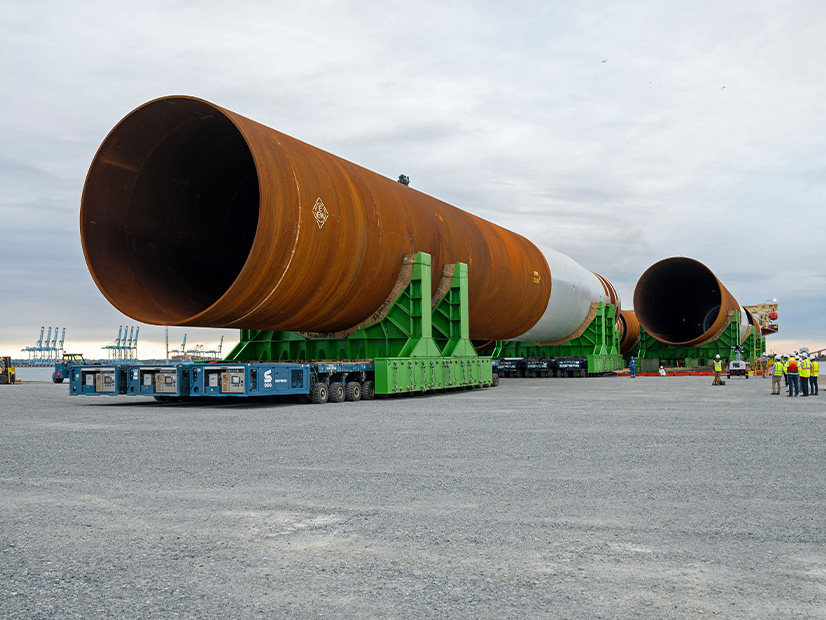
Federal regulators have approved the nation’s fifth and so far largest utility-scale offshore wind farm: the 2.6-GW Coastal Virginia Offshore Wind project.
Federal regulators have approved the nation’s fifth and so far largest utility-scale offshore wind farm: the 2.6-GW Coastal Virginia Offshore Wind project.
Dominion Energy has been gathering components in anticipation of the Record of Decision that the U.S. Bureau of Ocean Energy Management issued Tuesday. Dominion said it plans to start construction in late 2023 and complete the work in late 2026.
The project is an integral part of the company’s move toward clean energy, it said.
“More than a decade of work has gone into the development, design and permitting of CVOW,” Dominion CEO Robert Blue said in a prepared statement. “Offshore wind is a vital part of our strategy to provide our customers with a diverse fuel mix that delivers reliable, affordable and increasingly clean energy.”
The project will entail up to 176 wind turbine generators rated at 14.7 MW each. The layout of the offshore infrastructure was modified from initial proposals to reduce impacts on fisheries and ocean navigation, based on input BOEM received during public comment periods.
The Record of Decision includes provisions to avoid impacts from construction and operation. BOEM said Dominion has committed to fishery mitigation funds to compensate the commercial and recreational fishing industries for any losses inflicted by CVOW. It also will take steps to reduce the chances of harm to protected ocean species.
The decision comes 10 years and two months after Dominion won Lease Area OCS-0483 in a BOEM auction. The 112,799-acre zone stands 23.5 nautical miles east of Virginia Beach.
Dominion has been laying the groundwork for the project even as it worked its way through the review process. It reached a milestone Oct. 27, when the first eight monopile foundations were offloaded at the Portsmouth Marine Terminal. The massive steel cylinders will be stored there to await installation, which is anticipated in spring 2024.
More than 750 workers have been involved in the project directly or indirectly as Dominion ramped up preparations for CVOW, most of them in the Hampton Roads region. The company said more than 1,000 workers will support the project’s operations and maintenance after construction is complete.
CVOW is the fifth commercial-scale project approved by BOEM, which previously greenlit the Vineyard Wind 1, South Fork Wind, Ocean Wind 1 and Revolution Wind projects.
But in another way, CVOW was first: Dominion installed two 6-MW turbines in the lease area for research purposes. When they went online in fall 2020, they provided the first grid-connected wind power in U.S. federal waters. (Rhode Island’s Block Island Wind Farm went online in 2016 but is in state waters.)
Wind power development off the Northeast coast has run into serious financial problems. Two major New England projects have canceled their power purchase agreements, and a third is in the process of doing so. Three major projects are at substantial risk of dropping out of New York’s development queue.
The problem in each case is that the developers locked in their revenue before they locked in their construction costs, then were socked by inflation and rising interest rates.
By contrast, construction is well underway on the first two projects, Vineyard and South Fork. CVOW seems to be in the same position: able to proceed to construction now because it locked in its costs early enough.
In a Sept. 5 news release, Blue credited Virginia lawmakers and regulators with creating a framework that allowed it to take those steps.
“[The framework] enabled us to take a differentiated approach to project development, securing agreements early with offshore wind suppliers for material and services while giving them confidence in our project’s completion,” Blue said. “This allows our vendors to maintain focus on delivering their equipment and services on time. Not only is our project on budget and on schedule, but it is also estimated to deliver electricity at a levelized cost that competes very favorably with the nation’s unregulated offshore wind projects while creating hundreds of jobs and millions of dollars of local economic benefit.”
In the same news release, Dominion said that it would de-risk the CVOW project by taking on a minority investor. And in a filing with the Securities and Exchange Commission in August, Dominion indicated the offshore wind installation vessel it ordered will cost more and take considerably longer to complete than initially projected.
The Charybdis is notable not only for its sheer size (473 by 184 feet) but because it is being built in Texas: It will be the first U.S.-built vessel of its kind and meet the domestic manufacture requirements of the Jones Act.
The industry trade group Oceantic Network — which until Monday was known as the Business Network for Offshore Wind — hailed the decision as great news.
“Dominion’s CVOW project is anchoring a critical corner of the emerging domestic supply chain, and advancing this project means supporting development of America’s first wind turbine installation vessel and substantial port redevelopment work,” Oceantic Vice President John Begala said in a news release. “The Hampton Roads area is abuzz with offshore wind activity and the federal government’s advancement of the CVOW project will continue advancing the area as a hub for the whole industry.”
BOEM still must approve the construction and operations plan, which would be the final greenlight for CVOW.


